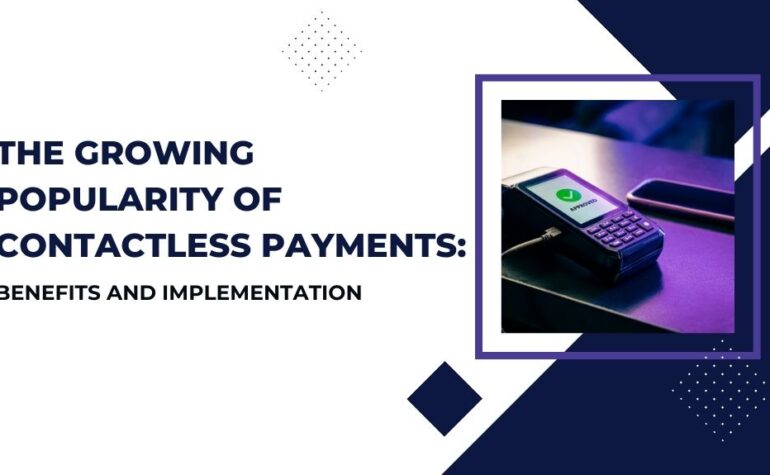Best Credit Card Processing Solutions Tailored for Every Industry

By merchantservices February 21, 2024
Introduction to Contactless Payments
Welcome to the era of convenience and speed in payments! Contactless payments have taken the world by storm, revolutionizing how we make transactions with just a tap or wave of our card or smartphone. Gone are the days of fumbling for cash or inserting cards into machines – contactless payment technology is simplifying our lives one transaction at a time. Let’s delve into the growing popularity, benefits, implementation, and future possibilities of contactless payments in this blog post.
The Benefits of Contactless Payments
Contactless payments offer a convenient and efficient way to make transactions without the need for physical contact. With just a tap or wave of your card, smartphone, or wearable device, you can securely complete your purchase in seconds. This streamlined process not only saves time but also reduces the risk of spreading germs – especially important in today’s health-conscious environment.
Moreover, contactless payments provide enhanced security features such as tokenization and encryption that help protect sensitive financial information from potential fraudsters. By eliminating the need to carry cash or handle physical cards, contactless payments also reduce the chances of theft and loss associated with traditional payment methods.
In addition to their practicality and safety benefits, contactless payments promote financial inclusivity by catering to individuals who may not have access to traditional banking services. This technology enables seamless transactions for everyone, regardless of their background or location.
How Contactless Payments Work
Contactless payments utilize near field communication (NFC) technology, allowing for seamless transactions without the need to swipe or insert a card. When making a contactless payment, a customer simply taps their card or mobile device on the payment terminal equipped with an NFC reader.
The transaction is completed within seconds as the data is transmitted wirelessly between the device and the terminal. The information exchanged includes encrypted payment details that are processed securely through the banking network.
This process eliminates the need for physical contact with cashiers or keying in pin numbers, providing a faster and more convenient way to pay for goods and services. Contactless payments have gained popularity due to their speed and efficiency, especially in environments where quick transactions are essential.
This technology simplifies the payment experience for both consumers and businesses alike, offering a secure and efficient alternative to traditional methods of payment.
The Evolution of Contactless Payment Technology

As technology continues to advance, so does the evolution of contactless payment methods. From the early days of contactless cards to now incorporating mobile wallets and wearables, the convenience and efficiency of these transactions have only improved.
Contactless payments have transcended beyond just tap-and-go at retail stores. They are now seamlessly integrated into public transportation systems, vending machines, and even parking meters. This widespread adoption showcases the versatility and adaptability of this technology in various sectors.
With innovations like biometric authentication and tokenization, security measures have been significantly enhanced to protect users’ sensitive information during contactless transactions. This continuous refinement ensures that customers can trust in the safety of their payment data.
Looking ahead, we can anticipate further advancements in contactless payment technology such as increased transaction limits, expanded compatibility with more devices, and potentially even more personalized user experiences tailored to individual preferences.
Implementation of Contactless Payments in Various Industries
The implementation of contactless payments has been rapidly expanding across various industries. In the retail sector, businesses are embracing this technology to provide customers with a faster and more convenient checkout experience. Restaurants and cafes are also adopting contactless payment methods to streamline transactions and reduce wait times for patrons.
In the transportation industry, contactless payments have revolutionized how people pay for their fares on buses, trains, and even taxis. This not only enhances efficiency but also improves the overall customer experience by eliminating the need for physical tickets or cash.
Moreover, in the healthcare field, contactless payments are simplifying billing processes and enabling patients to settle their medical expenses securely and conveniently. Educational institutions are also starting to integrate contactless payment options for tuition fees and campus purchases.
As we continue to witness advancements in technology, it’s evident that contactless payments will play an increasingly significant role in shaping how transactions are conducted across diverse sectors.
Security Concerns and Solutions
Security concerns surrounding contactless payments have been a hot topic in recent years. With the convenience of tapping to pay, questions arise about the safety of our financial information. One major concern is data interception during transactions, leading to potential fraud or identity theft.
To address these worries, companies are continuously enhancing security measures. Advanced encryption technologies ensure that sensitive data is securely transmitted and stored. Additionally, tokenization replaces actual card details with unique tokens for each transaction, adding an extra layer of protection against cyber threats.
Biometric authentication methods such as fingerprint scans or facial recognition further secure contactless payments by verifying the user’s identity before completing a transaction. Moreover, real-time monitoring systems detect any suspicious activity promptly and enable immediate action to prevent unauthorized access.
As technology evolves, so do security solutions aimed at safeguarding contactless payment transactions from malicious actors. It’s crucial for both consumers and businesses to stay informed about these advancements to ensure a safe and seamless payment experience in today’s digital age.
Future Predictions and Potential Growth

As technology continues to advance at a rapid pace, the future of contactless payments looks promising. With the convenience and speed they offer, it’s no surprise that contactless transactions are expected to become even more prevalent in the coming years.
Experts predict that contactless payments will continue to gain popularity across various industries, including retail, hospitality, and transportation. As consumers increasingly prioritize efficiency and safety in their transactions, the demand for contactless payment options is likely to soar.
Moreover, advancements in security measures such as tokenization and biometric authentication will further enhance the trustworthiness of contactless payment methods. This increased security will play a crucial role in driving adoption rates among both businesses and consumers.
The integration of contactless technology into wearable devices like smartwatches and mobile wallets indicates a shift towards a more seamless payment experience. This convergence of convenience and innovation suggests that the potential growth of contactless payments is bound to be substantial in the years ahead.
Conclusion
The growing popularity of contactless payments is evident in the numerous benefits it offers to both businesses and consumers. With its convenience, speed, and security features, contactless payments have revolutionized the way transactions are conducted across various industries. As technology continues to advance, we can expect contactless payment systems to become even more prevalent in our daily lives.
Businesses that implement contactless payment solutions stand to gain a competitive edge by providing a seamless and efficient payment experience for their customers. The evolution of contactless payment technology has paved the way for a future where traditional forms of payment may soon become obsolete.
As we look ahead, the potential for growth in the contactless payment industry is immense. With advancements in security measures and increasing consumer adoption rates, we can expect to see a continued rise in the use of contactless payments worldwide. Embracing this trend will not only benefit businesses but also enhance the overall shopping experience for consumers.
As we move towards a cashless society driven by digital innovation, contactless payments are set to play an increasingly integral role in shaping the future of commerce. By understanding its benefits and implementing secure systems, businesses can stay ahead of the curve and meet the evolving needs of their customers effectively.
